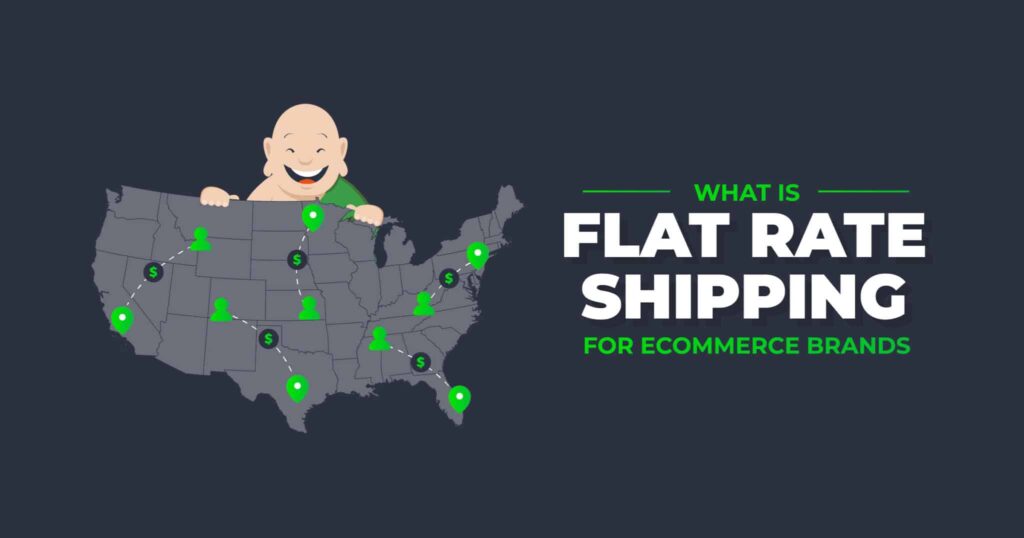For eCommerce direct-to-consumer (DTC) brands, calculating shipping costs can be a headache. There are so many variables at play that no two packages are the same, taking into account different sizes, different weights, and different destinations. That means, whether you’re fulfilling your own orders or a third party logistics company (3PL) is fulfilling them for you, each package has to be measured, weighed, and routed to find the least expensive shipping method. As such, if you aren’t carefully managing your shipping costs, it can make or break your eCommerce business.
In comparison, flat rate shipping sounds pretty simple, right? One price to ship anywhere in the U.S. in 1-3 days! For some brands, this may be a great alternative to standard shipping costs. But is it the best option for your products? Let’s take a look at how flat rate shipping compares to other options.
How Are Standard Shipping Rates Calculated?
Most major carriers, including USPS, FedEx, and UPS, use the same method to calculate standard shipping costs. They measure each package and perform a simple calculation to arrive at the package’s “dimensional weight” or DIM weight. Then they weigh the package to find its actual weight. The larger of the two (DIM weight or actual weight) is used to calculate billable weight. Then the carrier charges different rates for shipping than billable weight to shipping zones 1 through 8, based on how far the package is going from its point of origin. Confusing? No wonder flat rate shipping sounds so good!
What is Flat Rate Shipping?
There are two different kinds of flat rate shipping in the eCommerce world. The first simplifies shipping for the company; the second simplifies shipping for their customers.
- A shipping method that charges sellers one price
- A flat rate charge that sellers charge their online customers
Flat Rate Shipping for Sellers: USPS Priority Flat Rate Shipping is the most well-known flat rate shipping provider. USPS charges sellers one flat rate to ship a certain size envelope or box, as long the contents don’t exceed their 70lb. weight limit. Packages can be shipped anywhere in the U.S. for delivery in 1-3 days, depending on their destination. There are several box sizes to choose from, each set at a different price. The price includes the cost of the box, insurance, tracking, and shipping. All you have to do is pick and pack the order. For most brands, the 70lb limit eliminates the need for weighing and measuring orders. Note, that while the seller pays a flat rate, they can charge their customers more or less than that amount for shipping.
Flat Rate Shipping for Customers: Some DTC companies offer flat rate shipping to their customers, which has little to do with the actual cost of shipping an order. These companies calculate that they can cover their overall shipping costs by charging all customers the same price per order, no matter the size of the order. They set a price for shipping based on what their customers will tolerate, knowing they may lose money on large orders, but make up for it with higher margins and possibly a higher volume of small orders. The company then pays real-time shipping costs for each order.
Advantages & Disadvantages of Flat Rate Shipping Methods
There are advantages and disadvantages to each flat rate shipping method. Advantages to the USPS method fall mostly on the side of the company. Advantages to the “set-your-own flat rate” method fall mostly to the customer, but can also benefit the company.
How Much is USPS Flat Rate Shipping?
It’s important to note that other carriers, such as FedEx and some fulfillment companies, also offer flat rate shipping, so be sure to compare prices before committing to one carrier. Since USPS prices are readily available, we will use them for comparison purposes. Note, prices change frequently, so be sure to double check current pricing.
How to Set Your Own Flat Rate Shipping Price
If offering your customers flat rate shipping sounds appealing, how do you decide how much to charge?
Start by figuring out your average shipping cost per order. Take the total amount you spend on shipping per month (or any given timeframe) and divide it by the number of orders for that same period. Round up or down to the nearest dollar to make it simple. That flat rate should theoretically cover your shipping costs, though larger orders will cost more and smaller orders will cost less.
While you’re looking at the numbers, calculate your average order value (AOV). Find out how many orders in that time period are above AOV and how many are below. If, for example, a few large orders are skewing the AOV higher, then you could consider lowering your flat rate to cover most of your customers’ smaller orders, and offer your big spenders free shipping. You have a lot more flexibility when you’re setting your own rates, and can test different scenarios.
What’s Your Best Shipping Option?
That depends on several factors, including your fulfillment operations, your products and your order volume.
If You Are Self-Fulfilling Orders
- USPS flat rate shipping can lower your overhead costs by simplifying the shipping, insuring and tracking of orders.
- Since the cost is passed on to the end-customer, USPS flat rate shipping can expand your reach without increasing your costs.
If You Outsource Fulfillment to a 3PL
- Some 3PLs offer all-in-one pricing, so you know what each order is going to cost to fulfill. That makes it easy to calculate a flat rate that covers your costs.
- Even if your 3PL doesn’t offer a flat rate per package, standard shipping costs will likely be lower due to volume discounts that only a 3PL can offer.
- You may be able to lower your average shipping cost per order by storing your inventory in multiple warehouses in different locations. That way, orders can be fulfilled from the closest location, saving shipping costs. A 3PL like ShipMonk with multiple warehouse locations can easily manage this for you.
If Your Products Are Heavy for Their Size, Such as Books or Small Electronics
- USPS flat rate shipping can save you and your customers money when shipping long distances.
If Your Products Are Light, Such as Clothing or Jewelry
- Standard shipping might be the best option.
- If you want to offer customers a flat rate, you and your customers will be better off if you set your own price.
If You’re A Small-to-Medium Size eCommerce Business
- Either flat rate method can work, depending on the size and weight of your product.
- USPS flat rate shipping may simplify shipping costs, but only if you have the capacity to store products and pick and pack orders yourself.
- As your business grows, a 3PL can help you manage your shipping costs.
If You’re A Medium-to-Large Size Business
- Working with a 3PL to store, pick and pack orders will streamline your processes, prevent mistakes, and create efficiencies that translate to lower shipping costs.
- A 3PL can help you arrive at your own flat rate shipping charge, or help lower standard shipping costs.
Conclusion
Flat rate shipping sounds simple but may not be the right choice for your brand. USPS flat rate shipping makes sense if you’re a small business, your products are heavy for their size, and your customers are far away. But if you are a growing business, shipping thousands of packages a month, you can do better setting your own flat rate, or leveraging a fulfillment company to reduce shipping costs for you and your customers. A 3PL with multiple locations allows you to offer your customers multiple shipping options, including 2-day shipping, flat rate shipping, and economy shipping from anywhere in the country.
For more on eCommerce shipping strategies, visit our blog or contact ShipMonk today. We can help you get your products to your customers more efficiently and affordably, no matter where they live.





